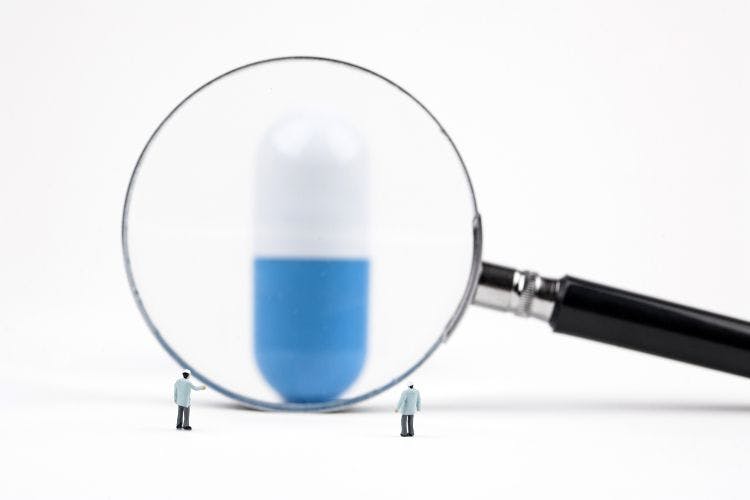Nutritional Outlook’s 2018 Best of the Industry Awards, Industry Leader: Global Retailer and Manufacturer Alliance
GRMA is a member-based organization harmonizing standards across multiple product categories to a single audit scheme.
Photo © iStockphoto.com/Rawpixel

In recent years, self-regulation has become a key dietary supplement industry priority. While many manufacturers have incredible reputations because of their long history of ensuring quality and safety, it has become clear that the most effective way to earn respect as an industry is to come together as one. That is why Nutritional Outlook is recognizing two self-regulatory initiatives: The Supplement Safety Compliance Initiative (SSCI) and the Global Retailer and Manufacturer Alliance (GRMA).
A sentiment shared by parties involved in both of these initiatives is that quality and safety are not competitive advantages for companies to leverage against others, but an ethical responsibility shared by all. That is the remarkable thing about SSCI and GRMA, that they each brought together stakeholders from across the industry-competitors, in most cases-to collaborate and develop high standards they can all agree on. Each offers a distinct self-regulatory pathway-SSCI, through benchmarking, and GRMA, through an entirely new standard-but they are not in conflict with one another; rather, they each have a valuable place in how the industry will regulate itself and collectively pursue a higher quality standard moving forward.
Global Retailer and Manufacturer Alliance
The Global Retailer and Manufacturer Alliance (GRMA) is a member-based organization that has brought together stakeholders from across numerous industries, including retailers, manufacturers, trade associations, certification bodies, as well as regulatory agencies and academic institutions, in order to develop a set of standards everyone can get behind. This is a process that has taken over four years, and the amount of time and effort that has been contributed by stakeholders cannot be overstated.
“Here, you have a group of retailers that are all fierce competitors, a group of manufacturers that are fierce competitors, and you have a group of certifying bodies that are fierce competitors,” Randy Slikkers, CEO of GRMA, tells Nutritional Outlook. “Industries don’t always break through that competitive nature to say, ‘Hey, it’s better for all of us if we do this.”
Joint Committees
Standard development was led by NSF International and accredited through the American National Standards Institute (ANSI). “ANSI requires a balanced group of stakeholders in an open and transparent consensus-building process to build the standards,” explains Slikkers. “So GRMA made a decision early on that instead of the standards being made by an entity like NSF and leave it at that, we wanted it to be done through the ANSI process, to add that additional layer to appeal to consumers, stakeholders, and retailers looking to ensure the quality chain remains at a high quality.”
NSF’s role is to serve as the facilitator of the standard development process, ensuring that the ANSI-accredited process is followed. This means coordinating meetings, sharing information, and including impacted stakeholders.
GRMA covers four product scopes: dietary supplements, cosmetics, over-the-counter drugs, and medical devices. Using each market’s regulatory requirements as the base, standards were developed for each of the four scopes by four joint committees dedicated to each standard, comprising shareholders that included manufacturers, retailers, certifying bodies, and others. A super joint committee then harmonized standards from across the different scopes to accommodate a single audit scheme, which then went back to the original joint committee to be voted on. This process is a constant back and forth.
“Once it got to the point they thought it was time to vote, it was put out for a vote,” explains Slikkers. “So, for instance, if you had a standard that had 50 subtexts and 45 of them passed, but there were negative comments on the other five, then those have to go back to the drawing board, address what the feedback was, reach a consensus again, and then voting is reopened.”
After everything is voted on and agreed to by joint committees, a 45-day public comment period is opened. These comments then go back to the joint committees to determine how to address them. “That process continues over and over and is part of why this process has taken almost five years because that’s just what needs to occur when you go through this process in a deliberative way,” says Slikkers. Nor is the process ever truly finished. This is an ongoing process in which the joint committees continue to exist and meet regularly to revise and improve the standards.
“That’s a huge part of the whole audit integrity program because as we complete our pilot audits and open up to do the real audits, we are ready to get feedback on a continual basis. That helps to address any issues that arise through the audit process, and if it’s an issue that is standards specific, it has to go back through the continual improvement process,” Slikkers explains.
The process certainly is not easy, but it is rewarding, says Christine Summers, assistant general manager over product safety and quality and environmental compliance for Costco, the membership-only wholesale club retailer. “I think at times it was frustrating,” Summers tells Nutritional Outlook. “It’s always frustrating when you’ve got a [large] group-I think there were 16 that were just joint committee members but there were many more participants than that. Sometimes you get bogged down on the semantics of something, but in general I found it to be a really good process. It was educational… it was very open. We could all say what we wanted to say because it’s non-competitive, so I learned a lot about some of the things manufacturers come against, [and] I think now the manufacturers have a better understanding of what retailers come against when dealing with customers.”
“These standards did take a ton of time, and that’s the benefit of using the ANSI standard, because with this consensus of the different interest groups, it’s not an industry-driven policy or procedure,” explains Mike Finamore, CEO of Gemini Pharmaceuticals (Commack, NY) and chairman of GRMA’s Governance Board, to Nutritional Outlook. “When you have an objective standard such as ANSI, it presupposes that it’s going to be the highest standard, and every interest group is represented in the process.”
The Audit
Audits are an important part of quality control because they determine whether a manufacturer meets cGMP standards as required by the U.S. Food and Drug Administration under 21 CFR Part 111. Retailers will often request to audit a manufacturer to make sure their products are qualified to be sold in their stores. When a manufacturer works with different retailers, this can lead to many audits, which becomes resource and time intensive. For example, Slikkers recalled that one manufacturer had over 80 audits in the span of a year. So, the goal of GRMA was to enhance consumer safety while streamlining the process for manufacturers.
“As a midsized manufacturer, we recognize that the cost of managing all of these different audits-all of which are best intended-will sometimes have diminishing returns due to both the interruption in manufacturing cycles and the distinctions between different auditors and their training. Sometimes this would lead to conflicting or contradictory findings during the audit, which ultimately didn’t deliver to the customer the value they were anticipating from having the audit,” explains Finamore. “So when GRMA was considered by retailers, the goal was to have a singular audit to the absolute highest standards, giving retailers and brand owners the confidence that a singular audit done to that scheme would allow the manufacturer to prepare and respond to that singular audit, and because of the depth and scope of that audit, the retailer will be able to rely on that singular audit score and not have the need to request additional audits of the manufacturing partner.”
Certifying bodies who want to participate in the audit process must be members of GRMA, then certified by the governance board that they meet GRMA’s qualifications and the capacity to conduct the audits. Once they are approved by GRMA to conduct audits, auditors are trained in the audit scheme and the standards of the different scopes.
Pilot audits are currently underway with three different audit groups. Each audit team consists of a retailer, a manufacturer, and a certifying body, as well as observers from GRMA and ANSI. Pilot auditor training was completed in October, with the first audits taking place in late October. “Once the final pilot audit is done, it will take about a month to use all that rich information we got to enhance the training, the auditor tool, and all the different components of what we do as scheme owners to ensure high-quality audits,” says Slikkers. “Full auditor training is now scheduled for the last week of January. At the completion of that training, the auditors are then tested and certified. Manufacturers will be able to request audits starting February 5.”
An Independent Nonprofit
Remaining independent is a crucial part of the GRMA to demonstrate impartiality and dedication to the highest standards possible. “We wanted people to understand that GRMA was not just an arm of NSF, and we’re not controlled by a small group of retailers or manufacturers,” explains Slikkers. “It really needed to be this independent body. So, in January of 2018, we became a nonprofit organization. In order to fulfill the legal obligations of a nonprofit organization, you have to have a governance board. That board has to operate in the manner of a nonprofit in that they’re making decisions that are best for the nonprofit, not the companies they work for. There is a legal standard for the duty of care, the duty of loyalty, and the duty of obedience.”
“The governance board manages the [audit] scheme and helps promulgate improvements and adjustments to the standards as things occur,” says Finamore. “If we see issues that continue to pop up, we can offer guidance documents or approach the standard’s joint committee with the opportunity to improve the standard or offer different definitions. We will also conduct annual meetings and roundtables where we’re able not only focus on the [existing scopes], but have additional related standards brought to the fore. So, it’s foundational to manage the scheme, and also providing us the foundation to grow as we move forward.”

Prinova acquires Aplinova to further increase its footprint in Latin America
April 7th 2025Prinova has recently announced the acquisition of Brazilian ingredients distributor Aplinova, which is a provider of specialty ingredients for a range of market segments that include food, beverage, supplements, and personal care.



















